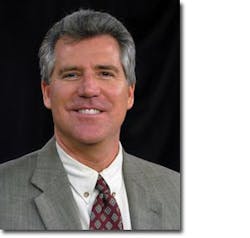One on One with Jim Elwood
Jim Elwood, A.A.E., director of aviation for the Aspen/Pitkin (CO) County Airport, took over as chair of the American Association of Airport Executives at this year’s annual meeting in New Orleans, at a time when the U.S. airport and aviation system is undergoing serious challenges. Yet, Elwood remains positive that this too shall pass — albeit not without a significant shift in how the industry operates. Says Elwood, ”As I said in my comments Wednesday night when the gavel was handed to me, we’ve been through difficult times before and we will find solutions and remain a strong industry through this transition as well. There are dark clouds on the horizon. We’ll do what we’ve always done, which is face it square on, address the issues, and be an even stronger industry on the other side.”
After taking over the AAAE helm, Elwood discussed the challenges facing airports and the U.S. aviation system with AIRPORT BUSINESS. Following are edited excerpts ...
AIRPORT BUSINESS: How is the current situation with the airlines impacting your airport in Aspen?
Elwood: We’re obviously watching the situation to see what changes are being made throughout the airline industry. We’ve not seen much in the way of changes at our airport. Our traffic is about 60/40, winter/summer at our airport. So, we’re still at a pretty good seasonal demand for summer. We’re anticipating probably a small downturn in seats in the fall.
AB: What was the overall message you were hearing from airports in New Orleans?
Elwood: A prime discussion was about the cost of fuel and the fact that the airlines are in a very, very difficult spot again. The industry experts are calling for somewhere around a 20 percent reduction in capacity, and that fares will need to go up probably much higher than the 20 percent capacity reduction might show.
Are there going to be fewer airlines on the other side of this economic shift? There are opinions on both sides.
Fuel has taken the headline; reauthorization is in the shadows. Obviously, every airport is concerned about how capacity shifts affect their airport and their community, and how to schedule capital plans, how to make strategic decisions for their airport when there’s a great deal of unknown just ahead of us. It was a prevailing theme.
AB: AAAE is putting together an Energy Summit to get the discussion going on how the current situation is affecting airports and communities. Your thoughts on the goals?
Elwood: There’s a great deal of interest from the industry — a very broad-based coalition of the aviation alphabet groups who recognize the difficulty of the issue. Certainly, there’s not likely to be a simple or easy solution that’s going to come from this. But it is important that we start to talk about and look for answers, and let folks know that aviation does not have an alternative fuel source in the near term.
Congress is a key part of that, so that they start to understand how this issue might affect the country as well as their districts. However, there needs to be interest from the general population as well.
AB: It would seem that for some small communities that may lose air service, business aviation and charter may take a higher profile role. Your thoughts?
Elwood: It’s a very important component. General aviation provides a great service to this country, as do the carriers. We are, in the end, one industry.
Early in my college education, I had a professor who explained that every airport in this country has value to the national airspace system, and if we lose an airport for whatever reason the collective value of the system is reduced.
If a sizeable number of communities lose commercial service, their access to other communities and commerce quite frequently shifts to general aviation in some fashion.
AB: Is there heightened potential for very light jets in this environment?
Elwood: There very well could be.
But more importantly we need to get the NextGen system up and operational as quickly as possible and take advantage of the components of NextGen that allow the greatest efficiency for an aircraft to go from one place to another and use the least amount of fuel possible. With energy being so high it’s clear that we need the greatest efficiency in our air traffic as possible.
AB: Do you foresee expansion of the Essential Air Service program?
Elwood: I think one of the concepts that should be pursued further is how that program can help communities that have already lost commercial air service, and ensure that the greatest portion of the traveling public still have a way to access it.
AB: Regarding the reauthorization debate in Congress, a key issue for airports has been the call for an increase in the cap on passenger facility charges. What’s the status of that initiative?
Elwood: As you know, the House bill has a PFC increase; the Senate version does not speak to PFCs. The airport community continues to believe that an increase in those PFCs are needed not only to offset the loss to the value of construction dollars because of rising costs. When you sit down and talk with airports about what their capital needs are, PFCs are a key component at most commercial service airports for getting improvements that are needed to create those efficiencies that are needed for the system to be effective.
AB: Congress continues to pursue the idea of 100 percent screen of all airport workers. How important is that effort?
Elwood: I really think that’s a program that doesn’t make the best use of available resources to reduce the risk of a bad person trying to do a bad thing. There are other ways that can achieve and tighten the perimeter around airport without the 100 percent screening.
